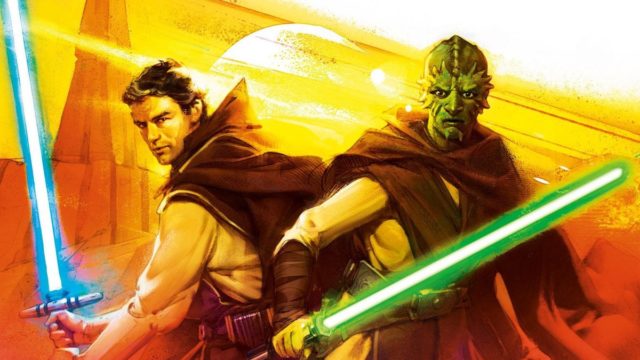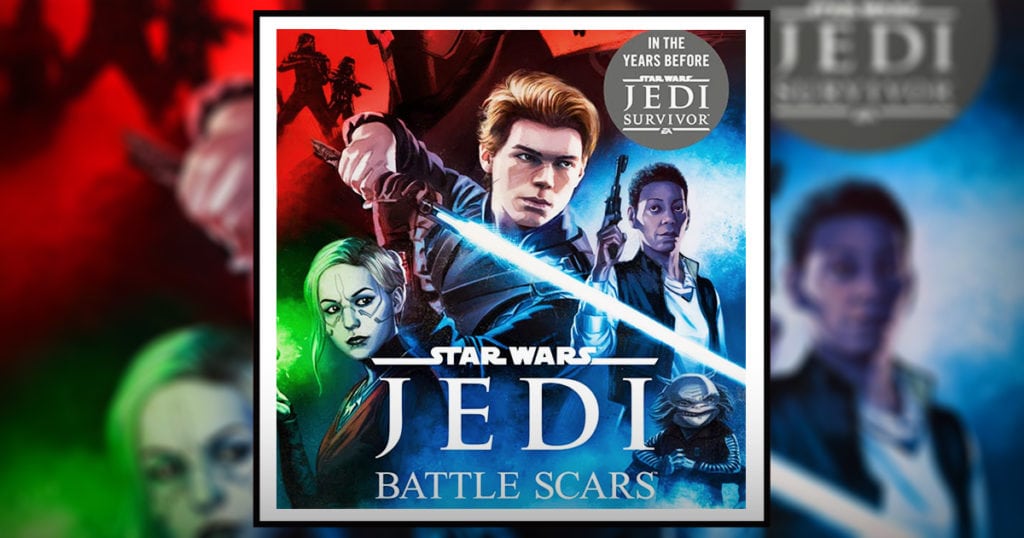Book Review: ‘Star Wars: The Battle of Jedha’ by George Mann

The Star Wars franchise is incredibly expansive across all forms of entertainment. Beginning with A New Hope in 1977, the franchise has spawned numerous sequels, both animated and live-action series, video games, audio dramas, and plenty of books. Each entry works to develop and enrich the lore and world of Star Wars, covering different eras and points of view. One of the newer works, Star Wars: The Battle of Jedha by George Mann, was originally produced as an audio drama set in the High Republic.
The Battle of Jedha follows the story of feuding worlds Eiram and E’ronoh, whose people decide to lay down arms and strike up a peace treaty. Representatives from these two planets, along with some Jedi and other galactic emissaries, have convened on the neutral planet Jedha, in hopes of stopping the war once and for all.
This tale of politics, war, and above all hope has now been bound together in a printed version of the audio drama’s script. So is Mann’s bound script of Star Wars: The Battle of Jedha essential for your galactic collection? Let’s jet off to Jedha and explore what this script has to offer.
[Note: While I am reviewing this novel independently and honestly, it should be noted that it has been provided to me by Random House for the purpose of this review. Warning: My review does contain some light spoilers!]
A time for peace between Eiram and E’ronoh
Mann’s script begins with a flash forward, to the moment the unease on Jedha begins to boil over. The peace summit between Eiram and E’ronoh is assembled in the Second Spire of Jedha, hoping to end their feud after many years. The weight of the situation is heavy, as rioting outside the walls of the spire grows. The civilians grow restless and begin throwing rocks and driving speeder bikes through the windows, creating panic and devastation in a moment that is meant to be peaceful.
The story then jumps to 72 hours prior to the battle of Jedha, with the re-introduction of Jedi Master Creighton Sun and Jedi Knight Aida Forte. Through these two, readers discover that Jedi have been brought onto Jedha to help facilitate the peace between the two rival societies. Aida is more optimistic than Jedi Master Creighton, who is anticipating problems from the citizens of Jedha for bringing trouble to their planet. Part of the trouble stems from the absence of Chancellor Mollo and Greylark as Republic representation as well as the heirs to both Eiram and E’ronoh, all for different but justifiable reasons.
Joining these two on Jedha is fellow Jedi Master Silandra Sho, whose entrance is quite explosive. Arriving on a shotty transport shuttle, Sho has to hold the ship together with the force, as entrance into Jedha’s atmosphere threatened to tear it apart. However, she does manage to land the ship safely and begins her journey through the city with Mesook, an apparent friend of the Jedi Master.

On this meandering walk through a busy marketplace, Silandra comes face to face with the Path of the Open Hand, a religious sect that hates the Jedi. These extremists believe that no one should be able to manipulate the force for their own good.
To the group, when the Force is used, it seeks to restore balance, meaning that every action with the Force has consequences. If you save a life, another will be taken to restore that balance. Consequences that the Jedi don’t account for in their mission to save the world. Ultimately their goal on Jedha is to be accepted into the Convocation of the Force, where they’d have a say about the use and direction of the Force.
Tensions build on Jedha
As the script progresses, the peace summit and The Path of the Open Hand continue to make progress toward their respective goals. The pressure for peace builds for those involved with the summit, exhibited through Creighton’s anxiety about what’s to come if it all fails. There’s so much riding on these two planets reaching a common goal of tranquility, that it feels insurmountable at times. The pressure and panic are palpable throughout the script, all of which lead to the opening scene of The Battle of Jedha and beyond.
A war is coming, resulting from the explosion and destruction, however, the Jedi work hard to get to the bottom of the mystery first. The investigation and the subsequent battle span the rest of the story, building toward an epic Star Wars fight fans won’t want to miss. The sprawling battles are exciting in the ways I’ve come to expect from Star Wars novels, films, and series, with a satisfying conclusion.
The good and the bad from Star Wars: The Battle of Jedha
Putting the script from a previously released audio drama is an interesting move, for one reason alone. Reading a script, something that is meant to be acted out never hits the same way as the initial medium. Seeing the words on the page and feeling them voiced by an actor who can add nuance and layers to them are two vastly different experiences. I have always struggled reading scripts because the bare skeletons of a story don’t leave much for my mind to expand on.
That being said, Star Wars: The Battle of Jedha is one of the stronger scripts I’ve read in my life. Granted many of the scripts I’ve read were in college and more scholarly in nature, so that could have easily skewed my feelings about The Battle of Jedha. Mann wrote a hefty story, full of many exciting battles and scenes along with enjoyable characters that I became attached to.
Of those, Jedi Knight Aida was a standout to me. She reminded me a bit of Anakin Skywalker from Attack of the Clones, without the hint of cruelty bubbling under the surface. She had a lot of hope that things would work out, which is on brand for Star Wars. Of all the characters, I found her to be the most relatable, as someone who is younger, carefree, and wise beyond her years. I looked forward to the scenes where she was present, tearing through the other parts to get back to her quickly.
I also found the Path of the Open Hand deeply intriguing, as all cults seem from the outside looking in. Parts of their belief system make sense at their core, even if the way they achieve their goals raises eyebrows. It’s definitely easy to see how they can amass a following, with their values and presentation, as well as take advantage of galactic issues such as the feud between Eiram and E’ronoh.
I think their part in this story, as well as the entire High Republic timeline, is an interesting foil for the Jedi, who are at the top of their game. While my knowledge of the High Republic isn’t as deep as some of the other periods of Star Wars Lore, being introduced to the Path of the Open Hand in Star Wars: The Battle of Jedha makes me want to go back and catch up on them.
As stated above, scripts are difficult to read, because they lack context, thoughts from the characters’ heads, and the feel of the entire situation. All we have are the spoken dialogue from the audio drama, which is like the skeleton of the entire story. For me, that makes reading difficult, because I feel like I don’t have much to go on. Usually, when you listen to an audio drama, they add in music and background sounds, and you can hear the emotions through people’s voices, all of which make the story more robust.
Final thoughts on Star Wars: The Battle of Jedha
Overall, this script was good for what it was, the bare-boned structure of an audio drama that lacked much of the substance required for maximum enjoyment. Mann does a fantastic job with the story and characters and I fully intend to go and give the actual drama a listen.
Fans of Star Wars will absolutely want this for their collections, so they can dissect every word for clues as to where the High Republic is headed. For casual fans, I’d say just purchase the audio version and listen to it the way the author intended it to be listened to.
Star Wars: The Battle of Jedha by George Mann is available now and the audio drama available is on Audible. Have you read or listened to it? What are your thoughts on it? Let us know on Twitter or in The Cosmic Circus Discord. And if you haven’t already, check out our review of Star Wars Jedi: Battle Scars!
Book Review: Star Wars Jedi: Battle Scars by Sam Maggs




